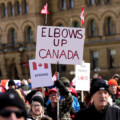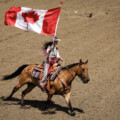This past Saturday, January 22, was the 30th anniversary of a great achievement for this country. Roberta Bondar became the first Canadian woman in space when the Sault Ste. Marie, Ontario native launched into orbit aboard the space shuttle Discovery. Prime Minister Brian Mulroney told her she had touched the lives of Canadians more than she could know, while her backup astronaut, Ken Money, said that “in any other country she would be a full-fledged hero but in Canada we think of ourselves as rather ordinary.”
Humility is an estimable quality, but in 2022 it is time we remember that this country has a lot to be grateful for and no shortage of moments to celebrate from its past. Rather than apologizing and engaging in too many bouts of national self-flagellation, let’s use this year to take note of significant occasions from our history and celebrate them. Roberta Bondar’s stellar accomplishment is just the start.

In April, the government of Prime Minister Justin Trudeau will have the irresistible opportunity to shine a light on the Canadian Charter of Rights and Freedoms, which will be marking its 40th anniversary. Despite the negative publicity surrounding the use of the notwithstanding clause in Quebec and Ontario, the Charter is widely held as an important component of Canadian identity and pride among citizens.
“Every nation needs a basic statement of what it stands for,” then-Chief Justice Beverly McLachlin said in the 2014 Brian Dickson lecture. “For Canada, the Charter was that statement. The Charter affirmed in express language the values implicit in the BNA Act of 1867—our democratic rights and our respect for difference and diversity.”
There is the added historical bonus that the 1982 document integral to this country’s sense of itself was the product of the leadership of the prime minister’s father, Pierre. This coincidence at the hands of Clio, the muse of history, will add a significant human touch to any celebration the government undertakes to celebrate this formative moment.
Not all anniversaries in 2022 are uplifting. This year will also mark 80 years since the Raid of Dieppe in the Second World War. While the Trudeau government does not exalt the country’s military history in the same way Prime Minister Stephen Harper’s did, no one should ignore August 19, 2022, when it comes around. More than 900 Canadian soldiers were killed on that day and another 2200 were taken prisoner. Mona MacTavish Gould put it well in her 1943 poem, “This Was My Brother,” writing in the first stanza:
This was my brother At Dieppe
Quietly a hero
Who gave his life
Like a gift,
Withholding nothing.
Justin Trudeau is well aware of the moment. At the 75th anniversary of the raid in 2017, the prime minister dramatically ended his speech by putting away his umbrella despite a thunderstorm at the National War Monument in Ottawa.
“As we sit here in the rain, thinking how uncomfortable we must be as our suits get wet, and our hair gets wet, and our shoes get wet, I think it is all the more fitting as we remember on that day in Dieppe, the rain wasn’t rain, it was bullets. As we stand here 75 years later with this duty and act of remembrance, it is all too fitting.”
Perhaps the most significant anniversary this year, however, involves neither the constitution nor the military, though it was a war of a different sort—and one any Canadian 56 years of age or older will likely remember: Paul Henderson’s winning goal in Game 8 of the 1972 Summit Series versus the Soviet Union.
There will be no shortage of reminiscing when September 28 approaches, the day Henderson—with just 34 seconds remaining in the game—slid the puck past Soviet goaltender Vladislav Tretiak while Foster Hewitt yelled that “Henderson has scored for Canada!” Some will have chills just reading that phrase. The goal, for those not around at the time, gave Canada the victory in the Cold War showdown (4-3-1), coming from behind after winning just one of the first four games on home ice.
“The Summit Series remains one of the few athletic events that transcended Canadian sport to become part of our collective consciousness,” noted Chris Webb in the 2009 book 100 Photographs That Changed Canada. Ottawa writer Andrew Cohen even suggested it might be the greatest day in the nation’s past.
That kind of history is political gold, and the prime minister will be wise to associate himself with it. According to a 2021 poll by Angus Reid, more than 90 percent of Canadians agree that hockey is part of our identity—and those who identified as visible minorities were just as likely to agree. All of this is in the government’s wheelhouse.
This year has much for the Dominion to celebrate—it need only look to its past. There were achievements in science, acts of bravery in war, progress in rights, and dramatic victory in the game the country holds so dear. And if literature is your thing, you can always pick up a copy of Mordecai Richler’s greatest novel, Barney’s Version. The 1997 Giller Prize-winner marks its 25th year since publication in 2022.
Recommended for You

Ben Woodfinden: Lament for an ‘elbows up’ nation

Falice Chin: The ‘wild and weird’ Calgary Stampede

‘A celebration of the spirit of Alberta’: Ryan Hastman on the political, economic, and cultural importance of the Calgary Stampede

Michael Geist: Children accessing porn is a problem, but government-approved age verification technologies are not the answer




